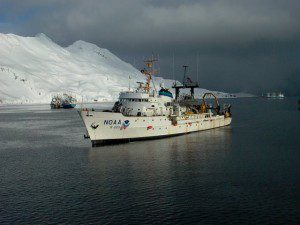
25 Feb EARTH MATTERS: NATIONAL OCEAN POLICY
Editor’s note: Environmental activist and scholar Anna Zivian (see Our Writers for her full and very impressive credentials) continues the new, weekly blog she and Billy Mason are writing for TIO. “Earth Matters” is designed to keep our readers on top of top news about our environment, land and water, flora and fauna.
 I realize that I left a hook dangling from my last post, but my fish story (about transgenic salmon) will have to wait for another day – soon, I promise. The exigencies of federal comment deadlines have led to this last minute shift of topic. Monday, February 27, at midnight EST is the deadline for commenting on the National Ocean Council’s Draft Implementation Plan for the National Ocean Policy.
I realize that I left a hook dangling from my last post, but my fish story (about transgenic salmon) will have to wait for another day – soon, I promise. The exigencies of federal comment deadlines have led to this last minute shift of topic. Monday, February 27, at midnight EST is the deadline for commenting on the National Ocean Council’s Draft Implementation Plan for the National Ocean Policy.
In July 2010, President Obama signed Executive Order 13547 establishing a national ocean policy “[T]o achieve an America whose stewardship ensures that the ocean, our coasts, and the Great Lakes are healthy and resilient, safe and productive, and understood and treasured so as to promote the well-being, prosperity, and security of present and future generations.” Many elements of the plan derived from two bipartisan national commissions: the congressionally-established U.S. Commission on Ocean Policy and the independent Pew Oceans Commission.
The National Ocean Policy called out nine priority objectives to protect, maintain, and restore healthy ocean ecosystems and to support the sustainable economic development that relies on functioning ecosystems (see http://www.whitehouse.gov/files/documents/OPTF_FinalRecs.pdf for the Final Recommendations of the Interagency Ocean Policy Task Force). These priority areas are:
Ecosystem-based management
Coastal and marine spatial planning
Inform decisions and improve understanding
Coordinate and support
Resiliency and adaptation to climate change and ocean acidification
Regional ecosystem protection and restoration
Water quality and sustainable practices on land
Changing conditions in the Arctic
Ocean, coastal, and Great Lakes observations, mapping, and infrastructure
The National Ocean Council prepared draft strategic action plans for each of these items last year. Based on comments on these drafts, it has now published the draft Implementation Plan for public comment. This plan is an important step towards a successful National Ocean Policy that looks at ocean and coastal issues comprehensively and in a coordinated fashion. Previously, the more than 20 federal agencies (and over federal 140 laws, not to mention state and local agencies and regulations) overseeing ocean issues did so in an uncoordinated, sector-by-sector basis. With the National Ocean Policy, we have the opportunity to prioritize conservation and coordinate activities.
A group of environmental non-governmental organizations, including Ocean Conservancy, for which I work, is submitting a comment letter on the Implementation Plan that covers some of the basic issues related to the plan. The plan is an excellent start to making the National Ocean Policy a reality, but it is worth calling out some of the points the groups are raising for those of you who might be interested in sending in your own comments:
Prioritize protecting, maintaining, and restoring the health of our oceans, coasts, and Great Lakes with an emphasis on achieving conservation milestones that can provide immediate ecological benefit such as the protection and restoration of coastal and marine habitat for priority species
Conduct regional assessments that identify important ecological processes and areas and inform the Regional Ocean Partnerships’ coastal and marine spatial planning processes
Advance the timelines provided for milestones for actions related to these key priorities: ecosystem-based management; prevent and mitigate pollution and harmful impacts to water quality caused by poor land use practices; and protect and restore marine habitat for priority species
Analyze potential interagency actions for resiliency and adaptation to climate change and ocean acidification which include regional reduction of carbon emissions
Establish regional planning bodies in New England and the Mid-Atlantic in 2012 and in the West Coast in 2013
Retain efforts to coordinate financial and educational resources to achieve the Plan’s goals
Produce a progress report on completion of the milestones in the Plan every two years and an Oceans, Coasts, and Great Lakes Health Report that notes progress on reaching set ecological indicators
I encourage you to look at the National Ocean Policy and the Draft Implementation Plan at the National Ocean Council website (http://www.whitehouse.gov/administration/eop/oceans/policy). As we move forward with the new policy, we have the opportunity to chart a course for healthy, productive coasts and ocean waters. In addition to their intrinsic beauty and their vibrant ecosystems, our ocean and coasts help regulate our climate (which includes the snow that falls in Telluride!), provide recreation opportunities, and drive our economy. Remember, every state is an ocean state!
Photo credits: Ocean Conservancy (squirrelfish); NOAA (ship)



Pingback:EARTH MATTERS: HAPPY BLUE YEAR! | Telluride Inside… and Out
Posted at 18:12h, 04 January[…] Ocean Policy adopted by President Obama in July 2010 (that I have written about previously – see https://www.tellurideinside.com/2012/02/earth-matters-national-ocean-policy.html) calls for ecosystem based management of our coasts, Great Lakes, and ocean. In the coming year, we […]